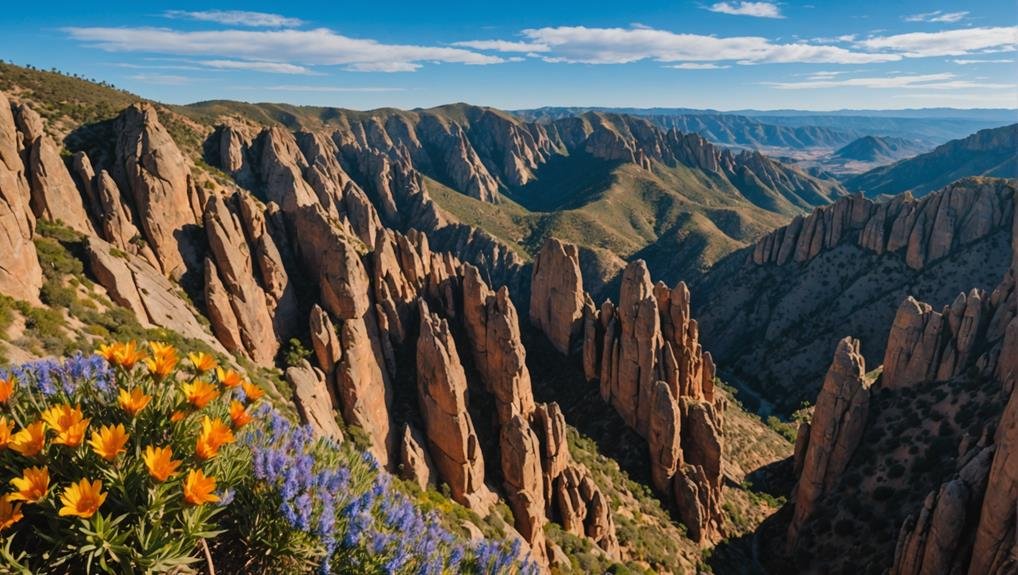When you visit Pinnacles National Park, you’re stepping into a landscape shaped by millions of years of geological activity. This park, recognized for its dramatic volcanic rock formations and diverse ecosystems, invites you to explore over 30 miles of trails that wind through oak woodlands and unique talus caves.
As you hike, you might glimpse the majestic California condor soaring above. Why was this area designated a National Monument long before it became a national park, and what’s the story behind its unique geology? There’s much more to uncover.
Key Takeaways
- Pinnacles National Park features unique volcanic rock formations and talus caves shaped by the San Andreas Fault.
- The park is home to California condors, prairie falcons, and over 400 bee species.
- It offers over 30 miles of scenic hiking trails through diverse terrains.
- Pinnacles Campground provides tent and RV sites with essential amenities.
- Visitors should start at the Center for maps, trail info, and cave exploration tips.
History
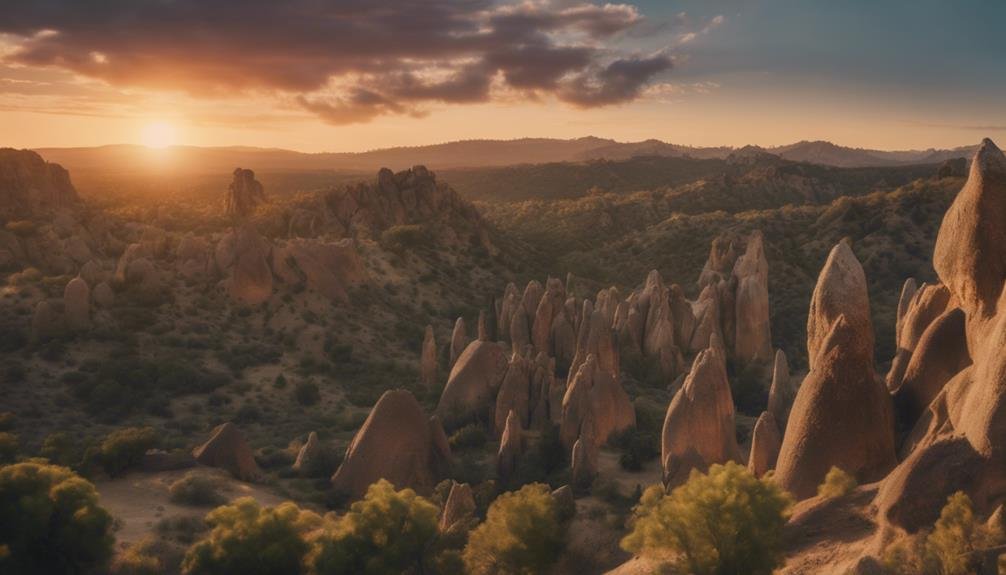
Pinnacles National Park’s history dates back to 1908 when President Theodore Roosevelt designated it as a National Monument. However, its roots stretch much deeper into California’s past. Before it became a protected area, the region was home to Native American groups like the Chalon and Mutsun Ohlone people.
These indigenous communities lived off the land, utilizing its rich resources for sustenance and cultural practices. Spanish colonization in the 18th century greatly influenced the landscape you see today. Spanish explorers and missionaries traversed the area, bringing changes that would forever alter the lives of its Native American inhabitants.
By the mid-19th century, the area saw an influx of Anglo-American settlers who arrived around 1865, drawn by the promise of fertile land and new opportunities. As the years passed, the importance of preserving this unique region became more evident.
Roosevelt’s designation of Pinnacles as a National Monument was pivotal, ensuring the protection of its diverse ecosystems and significant historical sites. In 2013, the park’s status was elevated, making it the ninth national park in California under President Obama‘s redesignation. Today, it is a testimony to the region’s rich and varied history.
Unique Geology
When you visit Pinnacles National Park, you’ll be amazed by its unique rock formations that originated from an extinct volcano 23 million years ago. The movement along the San Andreas Fault further shaped these volcanic rocks into the striking pinnacles you see today. You’ll also find fascinating cave systems created by this dynamic geological activity.
Volcanic Rock Formations
The unique volcanic rock formations at Pinnacles National Park, created by the ancient Neenach Volcano eruption 23 million years ago, draw rock climbers and geology enthusiasts alike. When you visit, you’ll be amazed by the towering spires, known as pinnacles, punctuating the landscape.
These volcanic rock formations are primarily composed of breccia, formed from volcanic ash, lava, and debris. As you explore, you’ll find talus caves—caverns formed by fallen boulders—that add an extra layer of intrigue to the park’s geologic history.
These distinctive pinnacles offer breathtaking views and challenging climbs for adventurers. The park’s unique geology reflects millions of years of natural processes. You can learn more about this fascinating history through the park’s guided tours and interpretive programs.
As you navigate the park, you’ll see how volcanic activity and subsequent erosion have sculpted these formations into today’s dramatic landscape. So, whether you’re scaling a spire or wandering through a talus cave, Pinnacles National Park offers an enthralling glimpse into Earth’s dynamic past.
Tectonic Plate Movements
You’ll be fascinated to learn how tectonic plate movements along the San Andreas Fault have sculpted the unique geology of Pinnacles National Park. The park’s dramatic rock formations, including its iconic spires and crags, are remnants of an ancient volcano that split due to fault movement.
This ancient volcanic activity, coupled with the relentless tectonic shifts, has created today’s rugged and distinctive landscape. The interaction between the Pacific and North American Plate is the driving force behind this dynamic geological environment.
As these massive plates grind against each other, they continue to reshape the terrain, contributing to the park’s ever-evolving formations. The ongoing tectonic activity ensures that the park remains a living demonstration of the power of these natural forces.
When you visit Pinnacles National Park, you’ll witness firsthand the effects of these plate movements through the diverse geological formations scattered throughout the area. Each rock formation tells a story of ancient volcanic eruptions and continuous fault movement, providing a unique window into the Earth’s geological processes. Exploring the park offers a rare opportunity to see the tangible impact of tectonic activity on the landscape.
Climate Overview
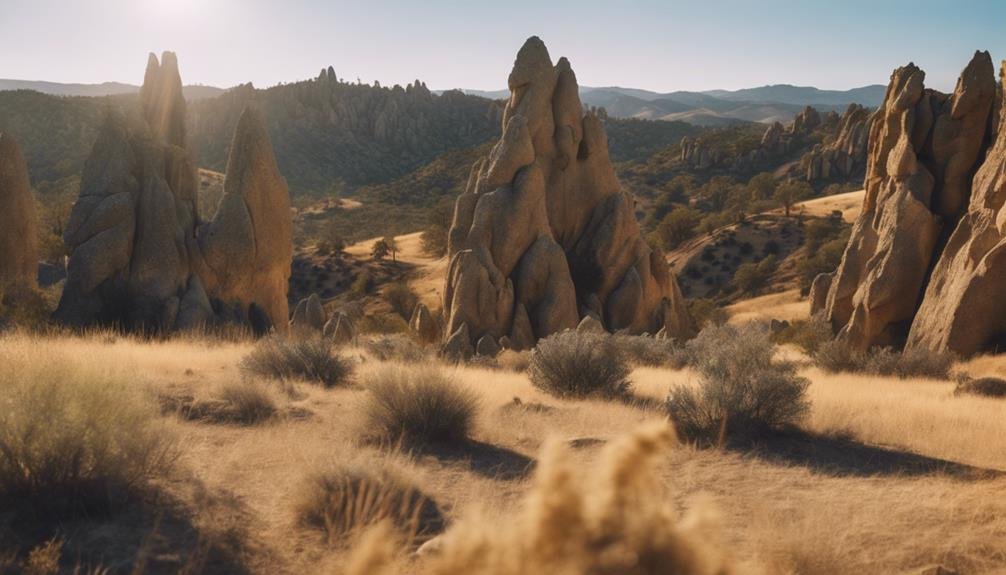
Pinnacles National Park greets you with a hot-summer Mediterranean climate, where temperatures swing from a chilly 30°F in winter to a sizzling 100°F in summer. This unique climate shapes your experience as you explore the park’s National Parks-worthy landscapes, including talus caves and towering rock formations.
Winter months bring about 17 inches of rain, mostly from November to March, starkly contrasting the scorching, dry summers. When summer hits, the park’s dry heat can be intense, often exceeding 90°F. It’s essential to stay hydrated and protect yourself from the sun.
Spring and fall offer the best weather for hiking and other outdoor activities, with milder temperatures and blooming wildflowers enhancing your visit. This is the perfect time to explore the park’s intricate rock structures and hidden caves without the oppressive heat.
Winter presents a different experience, with cool, wet conditions and occasional frost or fog in the mornings. This quieter time allows you to experience the park’s serene beauty in a more tranquil setting. No matter when you visit, Pinnacles National Park’s climate adds a unique layer to your adventure.
Diverse Wildlife
Nestled within this unique park, you’ll encounter a breathtaking array of wildlife, each species contributing to the rich tapestry of its ecosystem. Pinnacles National Park is a sanctuary for California condors, one of the rarest bird species in the world. Their growing population here is proof of successful habitat preservation efforts.
As you explore the park, watch for prairie falcons and their impressive aerial displays. These agile hunters are a sight to behold as they soar through the skies. The park’s diverse wildlife extends beyond birds. You can hear the distinctive howls of coyotes echoing through the canyons and observe over 400 species of bees buzzing around, playing an important role in pollinating native plants.
Endangered species like the red-legged frog find refuge in the park’s riparian areas, showcasing the importance of preserving these habitats. Wildlife monitoring programs in the park track the health and populations of various species, providing valuable data for ongoing conservation efforts. Here’s what you might encounter:
- California condors: Rare and majestic.
- Prairie falcons: Agile and awe-inspiring.
- Red-legged frogs: Endangered and protected.
Scenic Hiking Trails
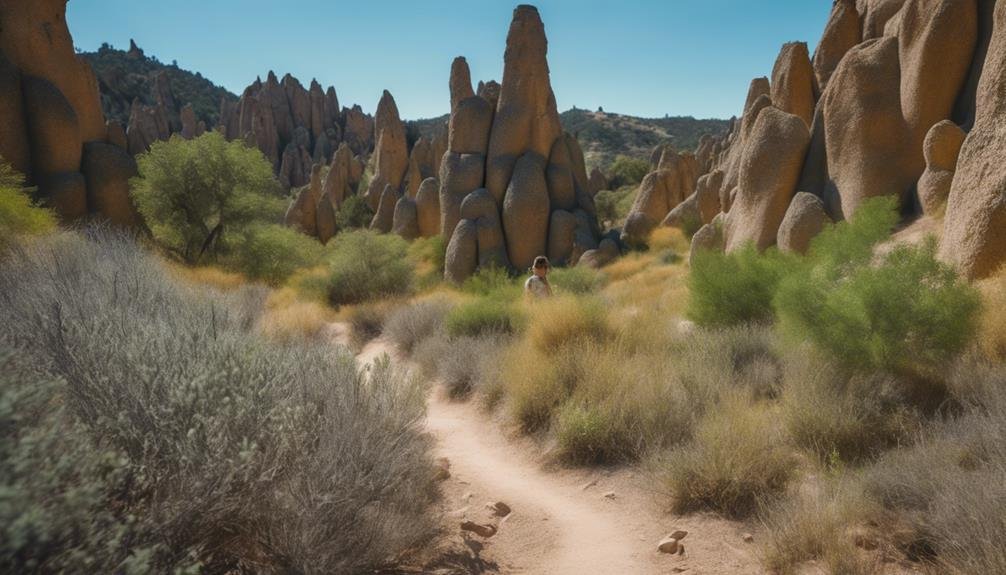
When you hike the trails at Pinnacles National Park, you’ll experience diverse terrain that ranges from rugged cliffs to serene reservoirs. Each trail offers unique wildlife encounters, like spotting California condors soaring above. Whether you choose the High Peaks Trail or the Moses Spring Trail, you’re in for an unforgettable adventure.
Diverse Terrain Exploration
Exploring diverse terrain is easy, with over 30 miles of scenic hiking trails that take you through chaparral, woodlands, and striking rock formations. As you journey, hikers enter rare talus caves, perfect for those seeking adventure. The East Entrance offers access to trails that weave through oak woodlands, providing a serene backdrop contrasting the park’s unique landscape. Here’s what you can expect:
- Talus Caves: Navigate through these rare formations created by boulders falling into narrow canyons, offering a thrilling underground experience.
- Spires Teeming with Life: The towering rock spires aren’t just geological wonders but habitats with diverse plant and animal life.
- Oak Woodlands: Enjoy tranquil walks under the canopy of ancient oaks, with the East Entrance trails offering some of the best scenery.
Trails like the High Peaks Trail reward you with panoramic views of the surrounding landscapes, making the climb well worth the effort. Whether you’re a novice or an experienced hiker, Pinnacles National Park caters to all skill levels, ensuring everyone can enjoy the natural beauty and diverse terrain.
Unique Wildlife Encounters
While hiking the scenic trails of Pinnacles National Park, you’ll encounter unique wildlife like California condors, prairie falcons, and coyotes. These trails, such as the High Peaks Trail and Bear Gulch Trail, offer stunning views of the park’s dramatic rock formations while providing a firsthand experience of its diverse ecosystem.
| Wildlife | Description |
|---|---|
| California Condors | Soaring overhead, these birds boast impressive wingspans and are a highlight for many hikers. |
| Prairie Falcons | These falcons are often seen gliding gracefully, which adds to the park’s avian diversity. |
| Coyotes | These elusive creatures can sometimes be spotted early mornings or late evenings. |
| Bee Species | Various bees contribute to the park’s vibrant ecosystem, often spotted around flowering plants. |
| Reptiles | Lizards and other reptiles bask on rocks, adding to the unique wildlife encounters. |
The opportunity to see California condors in flight is a memorable highlight. Watch for prairie falcons gliding above and coyotes moving stealthily through the underbrush as you traverse the trails. Each step along these trails allows you to immerse yourself in the natural beauty and unique wildlife encounters that make Pinnacles National Park a must-visit destination for nature enthusiasts.
Talus Caves Exploration
Venture into the talus caves at Pinnacles National Park to explore a world of dark passages, massive boulders, and thrilling adventures. As you begin this journey, you’ll find yourself traversing through impressive talus caves formed by boulders wedged into narrow canyons and crevices.
These cave systems, especially Bear Gulch Cave and Balconies Cave, offer a unique hiking experience different from typical trails. You’ll need a flashlight, sturdy footwear, and a sense of adventure to trek the rugged terrain in these caves.
The talus caves provide a refreshing escape from the summer heat and a chance to witness fascinating rock formations and wildlife. Keep an eye out for bats and other creatures that inhabit these dark passages. Here’s what you need for a successful talus cave exploration:
- Flashlight: Essential for manoeuvring through the dark passages.
- Sturdy Footwear: Necessary for climbing over uneven boulders.
- Adventure Spirit: Embrace the excitement of exploring these enthralling caves.
Exploring the talus caves at Pinnacles National Park is an unforgettable experience that combines physical challenge, natural beauty, and the thrill of discovering hidden underground worlds. Don’t miss out on this incredible adventure!
Camping Options
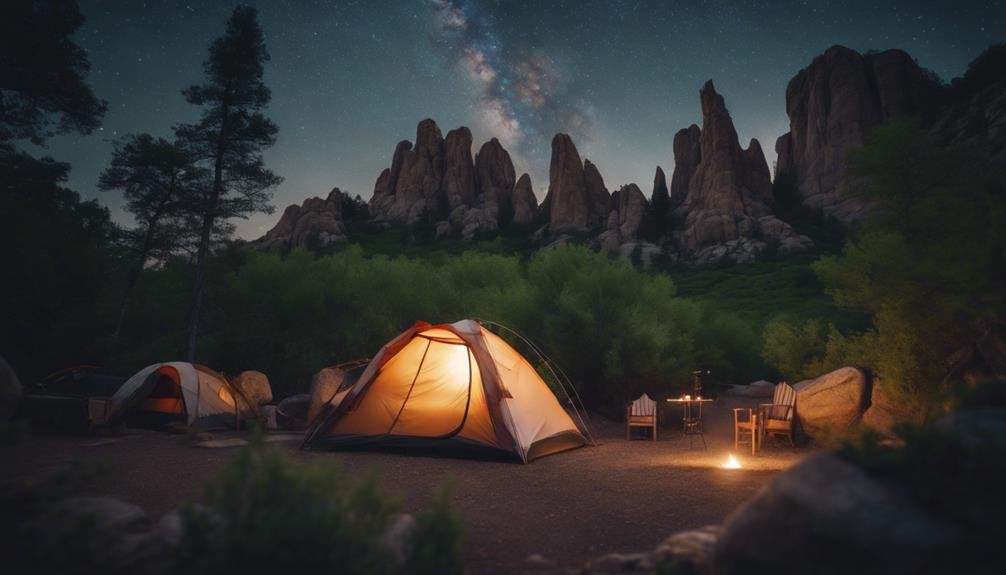
For an immersive experience at Pinnacles National Park, consider staying at the well-equipped Pinnacles Campground, which offers tent and RV sites. The campground features 134 sites, including tent-only, RV, and group campsites. You’ll find essential amenities such as restrooms and showers to make your stay comfortable.
Reservations are highly recommended, especially during peak seasons, and can be easily made through the park’s official website. This guarantees you secure your spot and avoid any last-minute hassles. The campground provides easy access to hiking trails, rock climbing areas, and wildlife viewing opportunities, making it an ideal base for park adventures.
Campfires are allowed in designated fire rings to enjoy a cosy evening under the stars. Just remember to follow Leave No Trace principles to protect the park’s natural beauty. Here’s a quick overview of the camping options:
| Camping Option | Details |
|---|---|
| Tent Sites | Perfect for traditional camping, close to nature. |
| RV Sites | Equipped with hookups for a comfortable stay. |
| Group Campsites | It is ideal for larger gatherings and group activities. |
Visitor Information
When planning your visit to Pinnacles National Park, it’s important to know key details to make the most of your experience. Start at the Visitor Center, where you can get maps, trail information, and updates on park conditions.
Hikers will find numerous trails ranging from easy walks to challenging climbs, with many leading to the park’s famous talus caves. The caves are a must-see, but bring a flashlight and check for any closures due to bat activity. To help you prepare, here are three key tips:
- Peak Seasons: Visit during spring or fall for the best weather and to avoid the summer heat.
- Camping: Reserve a spot at Pinnacles Campground in advance, especially during peak seasons.
- Wildlife Viewing: Look for California condors, particularly near the High Peaks.
The National Park Service website is an invaluable resource for planning your trip. It offers real-time updates and detailed guides. Whether you’re rock climbing, hiking, or simply enjoying the natural beauty, Pinnacles National Park has something for everyone. Respect park rules and preserve its unique environment for future visitors.
Conclusion
You’ve just scratched the surface of what Pinnacles National Park has to offer. With its fascinating history, unique geology, diverse wildlife, and scenic trails, there’s something for everyone.
Don’t forget to explore the intriguing talus caves and consider camping to immerse yourself in nature fully. Whether you’re a seasoned hiker or a casual explorer, Pinnacles National Park promises an unforgettable adventure. So pack your bags, hit the trails, and create lasting memories in this geologic wonderland.
